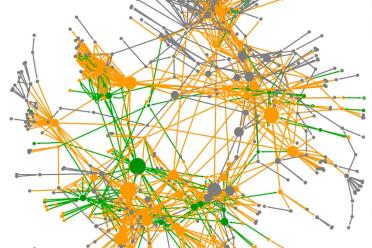
Cancer is caused by an accumulation of genetic changes in a cell, that overcome the normal checks and balances leading to uncontrolled growth. A complex, interacting network of proteins controls all of a cell’s processes, from metabolism to growth and division. The proteins pass signals around the network, integrating regulatory mechanisms to ensure its smooth running. But sometimes, environmental factors cause mutations that change how some of these proteins work, rewiring the network into a cancer cell.
To understand cancer and block its progression, scientists have identified which proteins are changed in different cancers, and targeted these with drugs that block their activities, so halting cancer progression.
While this is effective against some cancers, for others, such as ‘solid’ cancers in the bowel and lung, chemotherapy has only moderate success. New targets for novel chemotherapy drugs are urgently needed, and a new approach to finding the best targets in the complex protein networks that control our cells may point the way.
The new approach to finding drug targets relies on looking at the whole network of interacting proteins, rather than concentrating on just those that are mutated to trigger cancers.
“Increasingly, we are seeing cancer as a ‘systems’ disease,” said lead researcher Dr Tamás Korcsmáros from the Earlham Institute and Institute of Food Research. “This calls for a systems level approach, and network analysis techniques, to really understand how normal cells are transformed into cancer cells at the molecular level.”
Working with colleagues in Hungary and University of Cambridge, the team led by Dr Korcsmáros used databases of genes known to be involved in cancer, or that show major differences between healthy and diseased tissues, along with other resources detailing protein interactions in the cell, to create computational models of the protein networks in different types of cancer cells.
What was clear from this was that the cancer-related proteins tended to be very well connected at the centre of these networks, like a spider at the middle of its web. This isn’t surprising, as only the proteins that occupy these key global positions in a network have the ability to rewire it and bring about the different changes that characterise the switch from a healthy to a cancerous cell.
Others have seen how cancer-related proteins hold these central positions in networks. What Dr Korcsmáros and his team were interested in was the neighbours of these proteins. Could the proteins that neighbour cancer-related proteins at the centre of cellular signalling networks, not directly involved in carcinogenesis themselves, be useful drug targets themselves?
“When we looked at the network of proteins involved in colon cancer, we could see that the cancer-related proteins weren’t interacting with each other directly, but instead through their first neighbours in the network. First neighbours act like a ‘glue’ bringing the cancerous network together,” said Dr Módos, first author of the paper, from the University of Cambridge. “What’s more, the cancer-related proteins were using first neighbours to interact with the pathways controlling important processes for carcinogenesis, such as angiogenesis, autophagy and DNA repair. These neighbours were significantly amplifying the rewiring effect of the cancer-related proteins.”
The importance of these neighbour proteins was also seen in other networks constructed for breast cancer, hepatocellular carcinoma and non-small cell lung cancer, other ‘solid’ cancers where new drugs are needed to tackle high mortality rates. The research is published by Nature and the Systems Biology Institute in the journal Systems Biology and Applications.
“Our findings suggest that new drugs that target these first neighbour proteins could disrupt the cancer-specific networks, making them extremely useful for novel chemotherapies,” said Dr Korcsmáros. “Remarkably, our survey of drugs targeted to these proteins shows there are over 200 drugs already on the market that act against the first neighbour proteins we have identified, but that haven’t been used for cancer treatments.”
Because some of these neighbour proteins are as central and as global as the cancer-related proteins themselves, and link to so many other processes in the cell, there’s a strong likelihood that drugs targeting them may have strong side-effects. This could be overcome by targeting proteins that have a specific, directed influence on the first neighbour proteins, identified by analysing the interaction networks.
“We hope that by using these computational approaches to understanding cancer cell systems, we’ve widened the field for finding the new desperately needed cancer drugs,” said Dr Módos.
Dr Tamás Korcsmáros is a research fellow at the Institute of Food Research and Earlham Institute, two partners on the Norwich Research Park that receive strategic funding from the Biotechnology and Biological Sciences Research Council. This study was also funded by the Hungarian Science Foundation, the Hungarian National Developmental Agency, the Wellcome Trust, and the European Research Council.
"Neighbours of cancer-related proteins have key influence on pathogenesis and could increase the drug target space for anticancer therapies" is published in Systems Biology and Applications.1